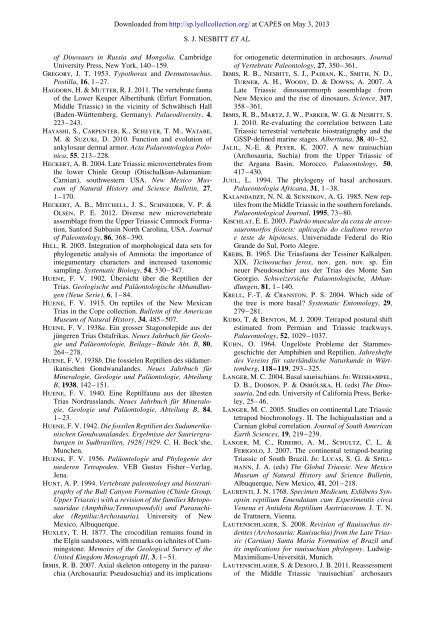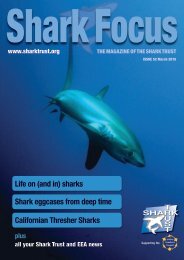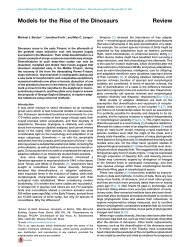(044) Nesbitt et al 2013
(044) Nesbitt et al 2013
(044) Nesbitt et al 2013
Create successful ePaper yourself
Turn your PDF publications into a flip-book with our unique Google optimized e-Paper software.
Downloaded from http://sp.lyellcollection.org/ at CAPES on May 3, <strong>2013</strong>S. J. NESBITT ET AL.of Dinosaurs in Russia and Mongolia. CambridgeUniversity Press, New York, 140–159.Gregory, J. T. 1953. Typothorax and Desmatosuchus.Postilla, 16, 1–27.Hagdorn,H.&Mutter, R. J. 2011. The vertebrate faunaof the Lower Keuper Albertibank (Erfurt Formation,Middle Triassic) in the vicinity of Schwäbisch H<strong>al</strong>l(Baden-Württemberg, Germany). P<strong>al</strong>aeodiversity, 4,223–243.Hayashi, S., Carpenter, K., Scheyer, T. M., Watabe,M. & Suzuki, D. 2010. Function and evolution ofankylosaur derm<strong>al</strong> armor. Acta P<strong>al</strong>aeontologica Polonica,55, 213–228.Heckert, A. B. 2004. Late Triassic microvertebrates fromthe lower Chinle Group (Otisch<strong>al</strong>kian-Adamanian:Carnian), southwestern USA. New Mexico Museumof Natur<strong>al</strong> History and Science Bull<strong>et</strong>in, 27,1–170.Heckert, A. B., Mitchell, J. S., Schneider, V.P.&Olsen, P. E. 2012. Diverse new microvertebrateassemblage from the Upper Triassic Cumnock Formation,Sanford Subbasin North Carolina, USA. Journ<strong>al</strong>of P<strong>al</strong>eontology, 86, 368–390.Hill, R. 2005. Integration of morphologic<strong>al</strong> data s<strong>et</strong>s forphylogen<strong>et</strong>ic an<strong>al</strong>ysis of Amniota: the importance ofintegumentary characters and increased taxonomicsampling. Systematic Biology, 54, 530–547.Huene, F. V. 1902. Übersicht über die Reptilien derTrias. Geologische und P<strong>al</strong>äontologische Abhandlungen(Neue Serie), 6, 1–84.Huene, F. V. 1915. On reptiles of the New MexicanTrias in the Cope collection. Bull<strong>et</strong>in of the AmericanMuseum of Natur<strong>al</strong> History, 34, 485–507.Huene, F. V. 1938a. Ein grosser Stagonolepide aus derjüngeren Trias Ostafrikas. Neues Jahrbuch für Geologieund P<strong>al</strong>äeontologie, Beilage–Bände Abt. B, 80,264–278.Huene, F. V. 1938b. Die fossielen Reptilien des südamerikanischenGondwan<strong>al</strong>andes. Neues Jahrbuch fürMiner<strong>al</strong>ogie, Geologie und P<strong>al</strong>äontologie, AbteilungB, 1938, 142–151.Huene, F. V. 1940. Eine Reptilfauna aus der ältestenTrias Nordrusslands. Neues Jahrbuch für Miner<strong>al</strong>ogie,Geologie und P<strong>al</strong>äontologie, Abteilung B, 84,1–23.Huene, F. V. 1942. Die fossilen Reptilien des SudamerikanischenGondwan<strong>al</strong>andes. Ergebnisse der Sauriergrabungenin Sudbrasilien, 1928/1929. C. H. Beck’she,Munchen.Huene, F. V. 1956. P<strong>al</strong>äontologie und Phylogenie derniederen T<strong>et</strong>rapoden. VEB Gustav Fisher–Verlag,Jena.Hunt, A. P. 1994. Vertebrate p<strong>al</strong>eontology and biostratigraphyof the Bull Canyon Formation (Chinle Group,Upper Triassic) with a revision of the families M<strong>et</strong>oposauridae(Amphibia:Temnospondyli) and Parasuchidae(Reptilia:Archosauria). University of NewMexico, Albuquerque.Huxley, T. H. 1877. The crocodilian remains found inthe Elgin sandstones, with remarks on ichnites of Cummingstone.Memoirs of the Geologic<strong>al</strong> Survey of theUnited Kingdom Monograph III, 3, 1–51.Irmis, R. B. 2007. Axi<strong>al</strong> skel<strong>et</strong>on ontogeny in the parasuchia(Archosauria: Pseudosuchia) and its implicationsfor ontogen<strong>et</strong>ic d<strong>et</strong>ermination in archosaurs. Journ<strong>al</strong>of Vertebrate P<strong>al</strong>eontology, 27, 350–361.Irmis, R. B., <strong>Nesbitt</strong>, S. J., Padian, K., Smith, N. D.,Turner, A. H., Woody, D.&Downs, A. 2007. ALate Triassic dinosauromorph assemblage fromNew Mexico and the rise of dinosaurs. Science, 317,358–361.Irmis, R. B., Martz, J. W., Parker,W.G.&<strong>Nesbitt</strong>,S.J. 2010. Re-ev<strong>al</strong>uating the correlation b<strong>et</strong>ween LateTriassic terrestri<strong>al</strong> vertebrate biostratigraphy and theGSSP-defined marine stages. Albertiana, 38, 40–52.J<strong>al</strong>il, N.-E. & Peyer, K. 2007. A new rauisuchian(Archosauria, Suchia) from the Upper Triassic ofthe Argana Basin, Morocco. P<strong>al</strong>aeontology, 50,417–430.Juul, L. 1994. The phylogeny of bas<strong>al</strong> archosaurs.P<strong>al</strong>aeontologia Africana, 31, 1–38.K<strong>al</strong>andadze, N.N.&Sennikov, A. G. 1985. New reptilesfrom the Middle Triassic in the southern forelands.P<strong>al</strong>aeontologic<strong>al</strong> Journ<strong>al</strong>, 1995, 73–80.Kischlat, E. E. 2003. Padrão muscular da coxa de arcossauromorfosfósseis: aplicação do cladismo reversoe teste de hipóteses. Universidade Feder<strong>al</strong> do RioGrande do Sul, Porto Alegre.Krebs, B. 1965. Die Triasfauna der Tessiner K<strong>al</strong>k<strong>al</strong>pen.XIX. Ticinosuchus ferox, nov. gen. nov. sp. Einneuer Pseudosuchier aus der Trias des Monte SanGeorgio. Schweizersiche P<strong>al</strong>aontologische, Abhandlungen,81, 1–140.Krell, F.-T. & Cranston, P. S. 2004. Which side ofthe tree is more bas<strong>al</strong>? Systematic Entomology, 29,279–281.Kubo, T.&Benton, M. J. 2009. T<strong>et</strong>rapod postur<strong>al</strong> shiftestimated from Permian and Triassic trackways.P<strong>al</strong>aeontology, 52, 1029–1037.Kuhn, O. 1964. Ungelöste Probleme der Stammesgeschichteder Amphibien und Reptilien. Jahresheftedes Vereins für vaterländische Naturkunde in Württemberg,118–119, 293–325.Langer, M. C. 2004. Bas<strong>al</strong> saurischians. In: Weishampel,D. B., Dodson, P.&Osmólska, H. (eds) The Dinosauria,2nd edn. University of C<strong>al</strong>ifornia Press, Berkeley,25–46.Langer, M. C. 2005. Studies on continent<strong>al</strong> Late Triassict<strong>et</strong>rapod biochronology. II. The Ischigu<strong>al</strong>astian and aCarnian glob<strong>al</strong> correlation. Journ<strong>al</strong> of South AmericanEarth Sciences, 19, 219–239.Langer, M. C., Ribeiro, A. M., Schultz, C. L. &Ferigolo, J. 2007. The continent<strong>al</strong> t<strong>et</strong>rapod-bearingTriassic of South Brazil. In: Lucas, S.G.&Spielmann,J. A. (eds) The Glob<strong>al</strong> Triassic. New MexicoMuseum of Natur<strong>al</strong> History and Science Bull<strong>et</strong>in,Albuquerque, New Mexico, 41, 201–218.Laurenti, J. N. 1768. Specimen Medicum, Exhibens Synopsinreptilium Emendatam cum Experimentis circaVenena <strong>et</strong> Antidota Reptilium Austriacorum. J.T.N.de Trattnern, Vienna.Lautenschlager, S. 2008. Revision of Rauisuchus tirdentes(Archosauria: Rauisuchia) from the Late Triassic(Carnian) Santa Maria Formation of Brazil andits implications for rauisuchian phylogeny. Ludwig-Maximilians-Universität, Munich.Lautenschlager,S.&Desojo, J. B. 2011. Reassessmentof the Middle Triassic ‘rauisuchian’ archosaurs




